genetic revision
1/178
There's no tags or description
Looks like no tags are added yet.
Name | Mastery | Learn | Test | Matching | Spaced |
|---|
No study sessions yet.
179 Terms
Genetics –
The branch of biology studying heredity and variation.
Inheritance –
The transmission of traits from parents to offspring. This is what keeps a mango seed from growing into an apple tree.
Variation –
The differences between offspring and their parents, or among siblings.
Gregor Johann Mendel – Father of Genetics
Performed hybridization experiments on garden pea plants (Pisum sativum)
Duration: 1856 to 1863 (7 years)
Applied statistical analysis & mathematical logic to biology for the first time!
Observed inheritance patterns using large sampling size
👨🔬 Who was Mendel?
Short life cycle
Easy to grow
Self-pollinating but can also be cross-pollinated
Showed clear contrasting traits
Why Pea Plants (Pisum sativum)?
Plants that show stable trait inheritance on continuous self-pollination
Mendel used 14 true-breeding pea plant varieties
🌿 True-Breeding Lines
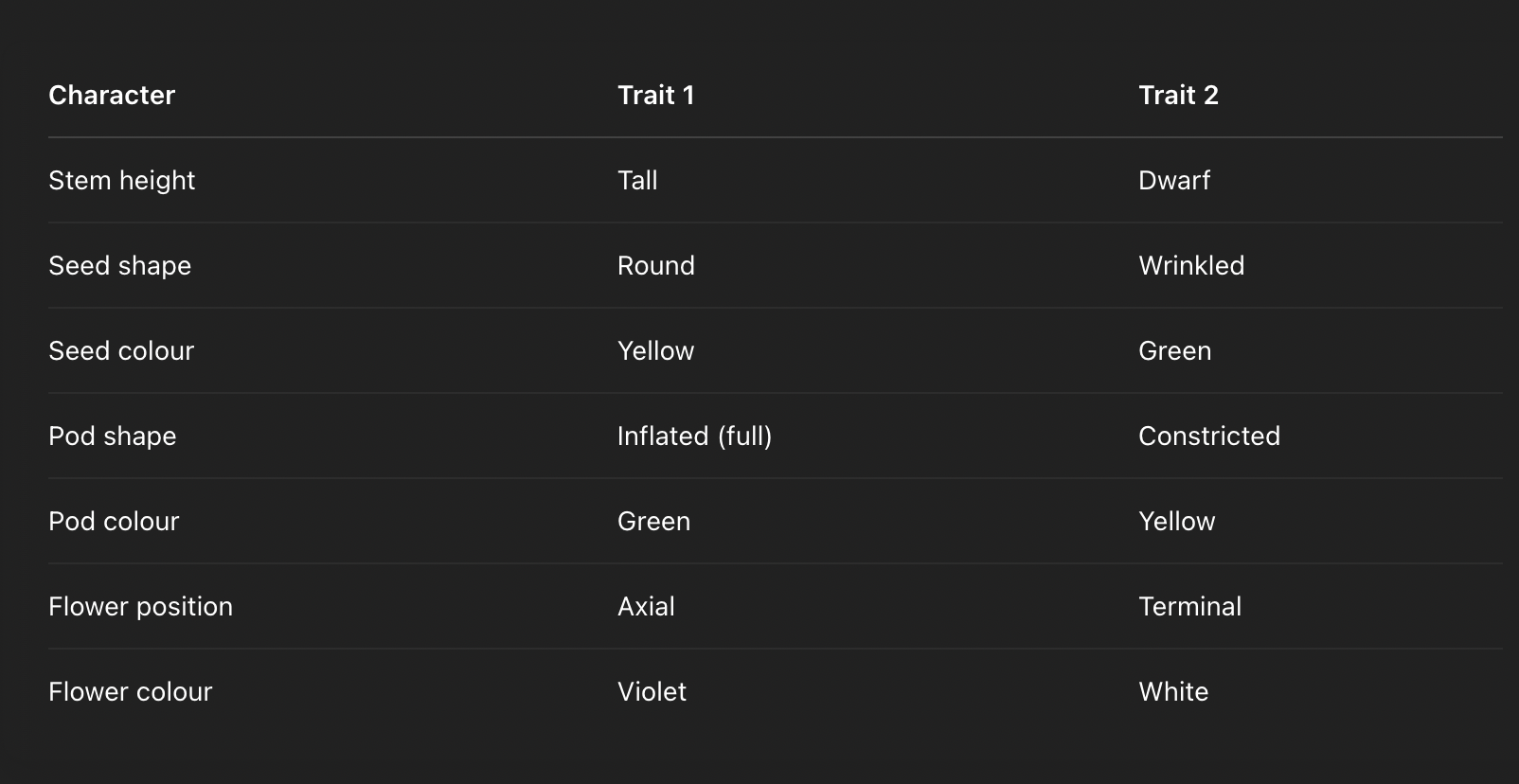
🔁
Selected pairs of traits with one contrasting character each
Performed artificial pollination / cross-pollination
Observed results over successive generations
Experimental Design
Proposed basic laws of inheritance
Results were repeatable and reliable
Formed the foundation for classical genetics
Key Outcomes of Mendel’s Work
🧬 1. Monohybrid Cross:
Cross between two true-breeding plants differing in one contrasting trait
Example: Tall (TT) × Dwarf (tt)
All plants were Tall (Tt)
Resembled only one parent → Tall = Dominant Trait
Dwarf trait not seen → Recessive
🌿 F₁ Generation (First Filial):
🔁 F₂ Generation (Self-pollination of F₁ i.e. Tt × Tt):
| Gametes from each Tt parent:
T and t (in equal proportion)
🧮 Punnett Square:
Genotype Ratio:
1 TT : 2 Tt : 1 tt (1:2:1)Phenotype Ratio:
3 Tall : 1 Dwarf (3:1)
Dominant trait appears 75% of the time, recessive 25%
F₂ Results:
No blending: Traits remained distinct, not mixed
Factors = Genes, passed from parents to offspring
Alleles: Alternate forms of a gene (e.g., T and t for height)
Genotype: Genetic makeup (TT, Tt, tt)
Phenotype: Physical appearance (Tall or Dwarf)
🧠 Key Concepts:
In heterozygote (Tt) → only T (Tall) is expressed
Hence, T is dominant, t is recessive
Dominance:
Cross between dominant phenotype plant (unknown genotype: TT or Tt)
×
recessive plant (tt)If offspring all tall → parent is TT
If 1:1 Tall:Dwarf → parent is Tt
🧪 Test Cross:
In heterozygous condition, one allele masks the expression of the other.
Mendel's Two Laws (from Monohybrid Cross): 1⃣ Law of Dominance
Alleles separate during gamete formation, and each gamete receives only one allele.
2⃣ Law of Segregation
🧮 BONUS: Binomial Representation
(½T + ½t)² = ¼TT + ½Tt + ¼tt → matches F₂ genotype ratio
🌟 LAW OF DOMINANCE (Mendel’s 1st Law)
📘 Definition:
In a heterozygous condition, one allele (factor) expresses itself (dominant), while the other remains hidden (recessive).
🧬 Key Points:
✅ Characters are controlled by discrete units → called factors (now called genes).
🔗 Factors occur in pairs → one from each parent.
💪 In a dissimilar pair (heterozygous) →
One factor is dominant, the other is recessive.
🌿 Application in Monohybrid Cross:
F₁ Generation:
Only the dominant trait appears
(e.g., Tall in Tt = Tall)F₂ Generation:
Both traits appear in a 3:1 phenotypic ratio3 Tall (TT, Tt)
1 Dwarf (tt)
🧬 LAW OF SEGREGATION (Mendel’s 2nd Law)
📘 Definition:
During gamete formation, the two alleles of a gene pair segregate (separate) from each other so that each gamete receives only one allele of the pair.
🔑 Key Points:
⚖ No blending of alleles
Both traits reappear in F₂ generation as distinct traits, not mixed.
Even if only the dominant trait appears in F₁, recessive shows up again in F₂.
🌱 Gamete Formation:
Alleles segregate randomly
Each gamete carries only one allele
💡 Example:
Homozygous TT → gametes: all T
Heterozygous Tt → gametes: T and t (in 1:1 ratio)
🎯 F₂ Generation Outcome:
Reappearance of both parental traits (e.g., Tall & Dwarf in 3:1 ratio)
🧠 Conclusion:
🔑Law of Segregation is universal – applies to all sexually reproducing organisms
Even when a trait is not expressed in F₁, it is not lost, just masked – and segregates out in F₂
🌸 INCOMPLETE DOMINANCE
📘 Definition:
Incomplete dominance is a type of inheritance in which neither allele is completely dominant over the other, resulting in a blending of traits in the F₁ generation.
🌼 Classic Example: 🔬 Snapdragon (Antirrhinum majus) Flower Colour
Parental Cross:
🔴 Red (RR) × ⚪ White (rr)
↓
🟣 F₁ Generation (Rr): Pink (Intermediate phenotype)F₂ Generation (Rr × Rr):
1 Red (RR) : 2 Pink (Rr) : 1 White (rr)
👉 Genotypic Ratio = Phenotypic Ratio = 1:2:1
🎯 Key Concept:
R (Red allele) is not completely dominant over r (White).
So, heterozygote Rr shows an intermediate phenotype (Pink).
This differs from complete dominance where dominant hides recessive.
🧬 Mechanism Behind Dominance:
Each gene codes for a product (e.g., enzyme).
Modified alleles may:
🔸 Make less efficient enzyme
🔸 Make non-functional enzyme
🔸 Make no enzyme at all
If only one allele is functional, phenotype depends on how much product is made.
If half the enzyme isn't enough to express full trait → incomplete dominance results.
🧠 Quick Recall:

🧬 CO-DOMINANCE
📘 Definition:
Co-dominance is a condition where both alleles in a heterozygote are fully expressed, leading to a phenotype that shows both parental traits simultaneously — not blending, but co-expression.
🩸 Classic Example: ABO Blood Groupi

ng

👥 Genotypes & Phenotypes:

🧠 Key Concept:
In IᴬIᴮ, both alleles produce their own sugars, so RBCs have both A and B antigens – no dominance or blending → Co-expression!
🔁 Multiple Alleles
A gene with more than two alleles in the population (but still only two in an individual).
🌟 ABO system has three alleles: Iᴬ, Iᴮ, i → example of multiple allelism.
🌽 Bonus Example: Starch Synthesis in Peas

📊 Summary Table:

Which of the following statements best defines pleiotropy?
A. A gene that is present on multiple chromosomes
B. A gene that controls only one phenotypic trait
C. A single gene that affects multiple unrelated traits
D. Multiple genes that affect a single trait
✅ Correct Answer: C
Explanation: Pleiotropy refers to a single gene influencing multiple phenotypic traits.
🌱 INHERITANCE OF TWO GENES – DIHYBRID CROSS (MENDEL'S 2nd EXPERIMENT)
🧬 Definition:
When two different traits are studied together in a cross, the inheritance pattern is called a Dihybrid Cross.
🌿 Mendel’s Example Traits:

🌼 Parental Cross:

🌿 F₁ Generation:
All offspring: RrYy (Round Yellow)
Phenotype: All round yellow (dominant traits)
Shows law of dominance.
🌱 F₂ Generation:
Selfing RrYy × RrYy
Gametes from each: RY, Ry, rY, ry
Punnett square gives 16 combinations.
🔢 F₂ Phenotypic Ratio (Dihybrid Ratio):
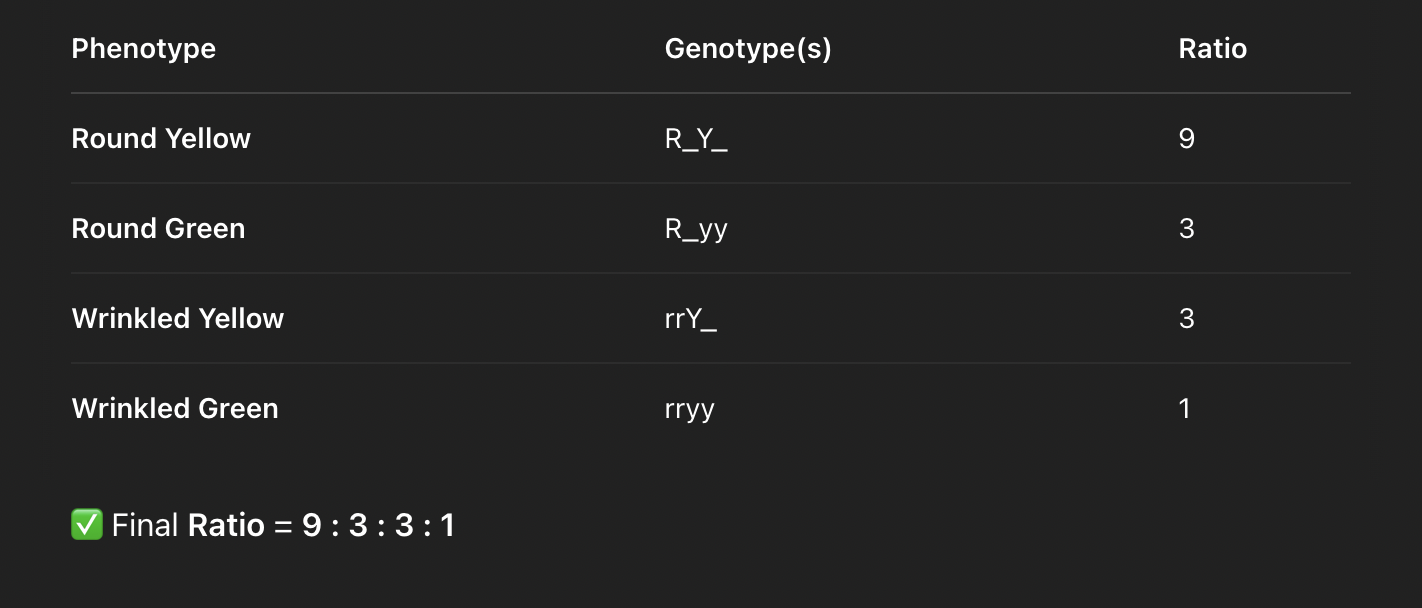
📘 Conclusion:
Each pair of alleles segregates independently —> Law of Independent Assortment
Two traits are inherited independently of each other.
🧠 Key Concepts Recap:
Law of Dominance → F₁ shows dominant trait.
Law of Segregation → Traits separate during gamete formation.
Law of Independent Assortment → Traits assort independently in F₂.
🧬 4.3.1 Law of Independent Assortment – Mendel’s 2nd Law
📜 Statement:
When two pairs of traits are combined in a hybrid, the segregation of one pair of characters is independent of the other pair during gamete formation.
🌱 Mendel’s Dihybrid Cross Example:
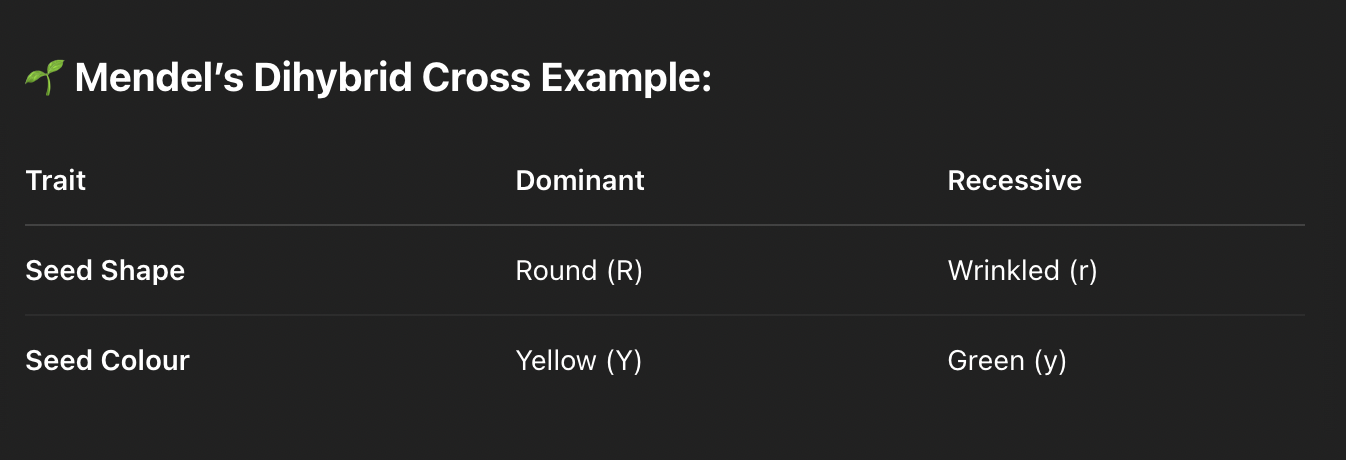
🧪 Parental Genotypes
RRYY (Round, Yellow) × rryy (Wrinkled, Green)
🔄 Gametes: RY and ry
🌼 F₁ Generation:
Genotype: RrYy
Phenotype: All Round Yellow (dominant traits)
🌾 F₂ Generation –
Selfing RrYy × RrYy
Gametes from each parent:
RY, Ry, rY, ry
🧩 Using Punnett Square → 4 × 4 = 16 combinations
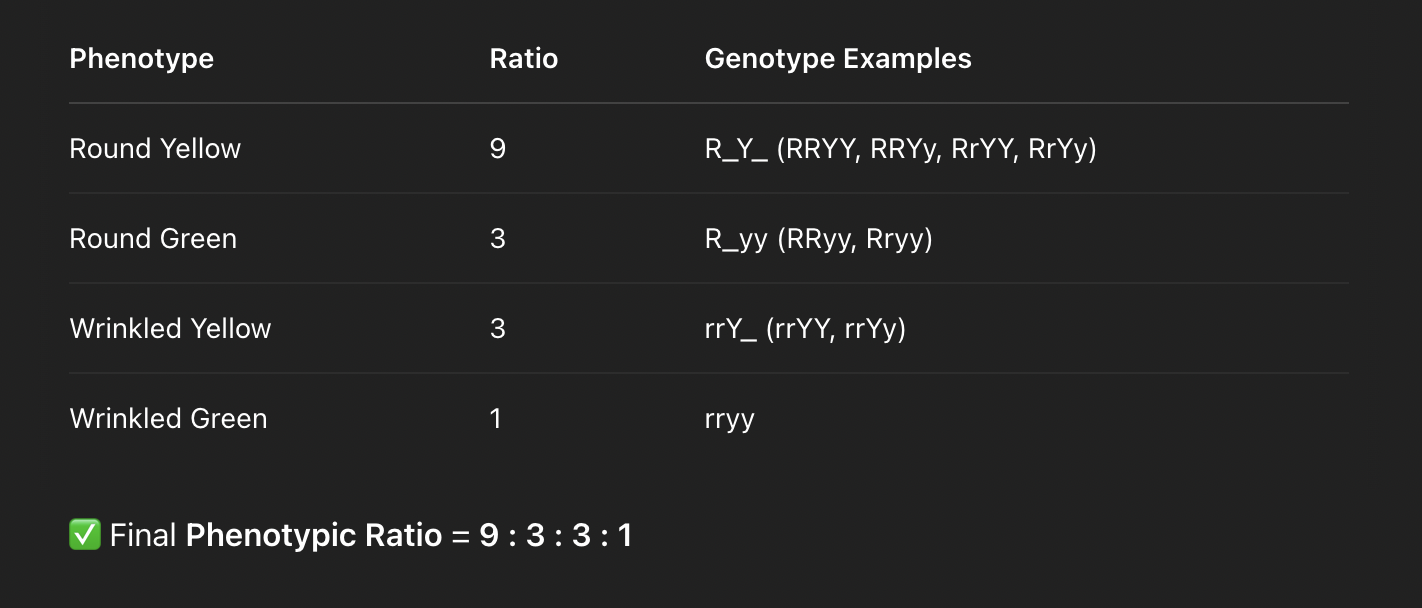
🎯 Phenotypic Ratio (Dihybrid Ratio):
🧠 Genotypic Ratio (All 16 Squares):
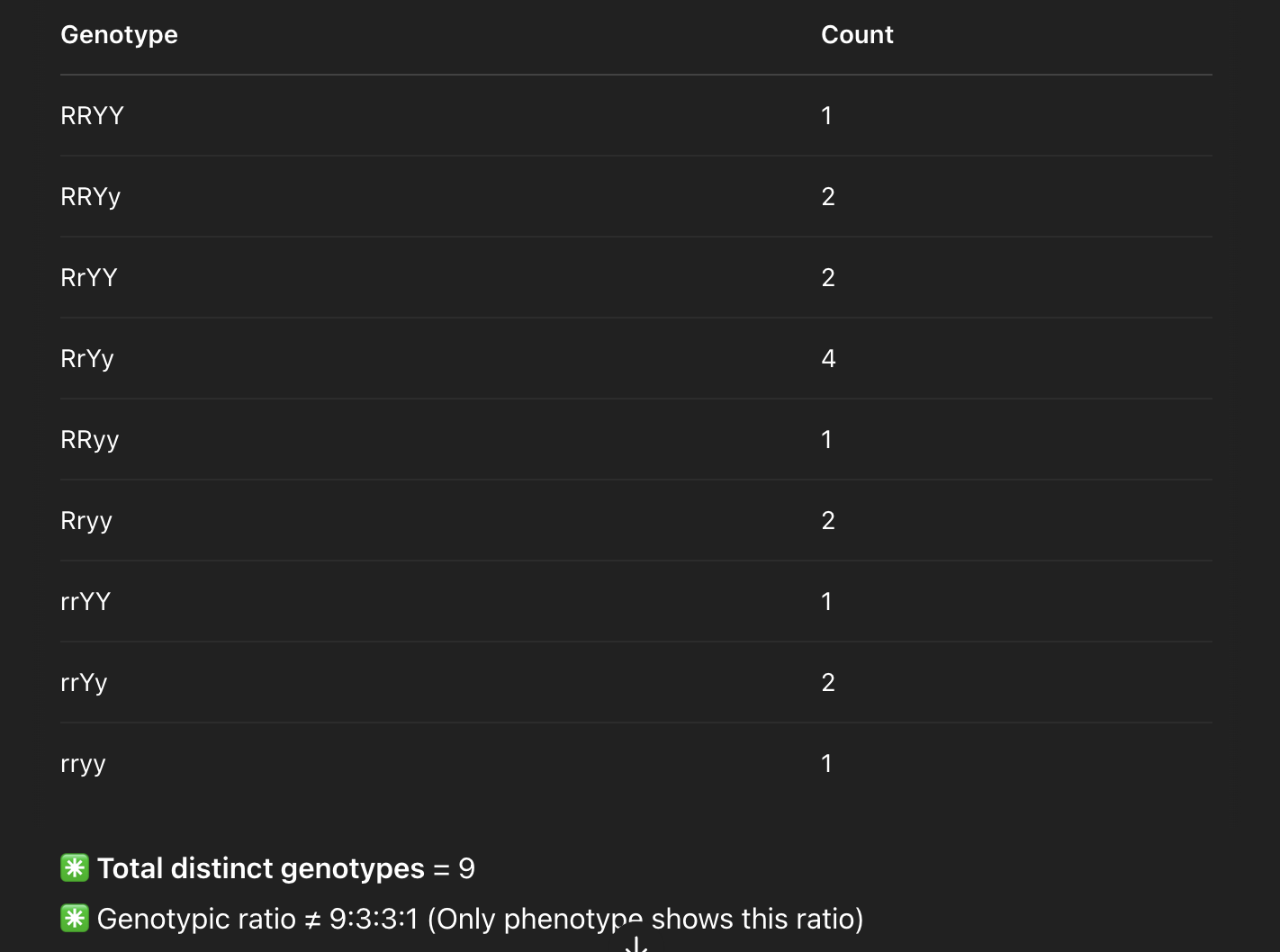
🧬 Why Independent?
Segregation of:
R vs r is independent of
Y vs y
This leads to 4 kinds of gametes: RY, Ry, rY, ry
Each with equal probability(25%)
Chromosomal Theory of Inheritance
📚 Background
🧑🔬 Gregor Mendel (1865): Proposed “factors” (now called genes) as discrete units of inheritance.
🔕 His work was ignored until 1900, due to:
Poor scientific communication
New concept of using mathematics in biology
Lack of physical proof of genes
Inability to explain continuous variation in nature
🔄 Rediscovery of Mendel’s Work (1900)
Rediscovered by:
Hugo de Vries, Carl Correns, Erich von Tschermak
🧪 Chromosomes Discovered
Visualized due to improved microscopy
Named chromosomes (colored bodies) due to staining
Found to double and divide before cell division
In 1902, meiosis and chromosome movement were understood
👨🔬 Sutton & Boveri's Observations (1902)
They proposed:
🎓 "Chromosomal Theory of Inheritance"
– Genes are located on chromosomes, and their segregation and assortment during meiosis explains Mendel’s Laws.

🧬 Key Concepts from Meiosis:
Homologous chromosomes carry allele pairs
During Anaphase I, homologous chromosomes segregate
Independent assortment happens at metaphase I — gene pairs on different chromosomes assort independently
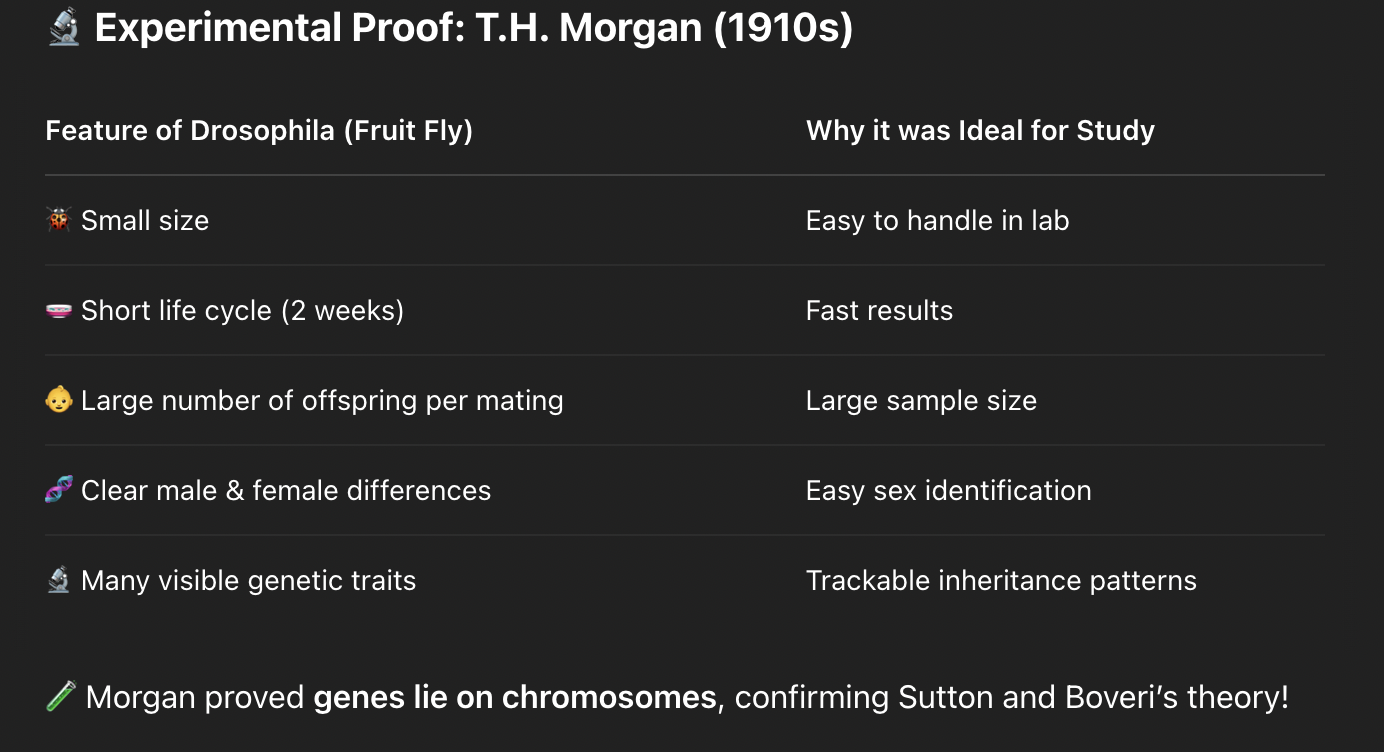
Example: Possibility I vs Possibility II
Possibility I: Orange + Green chromosomes segregate together
Possibility II: Orange + Red chromosomes segregate together
👉 Shows independent assortment
Experimental Proof: T.H. Morgan (1910s)
🧪 Morgan proved genes lie on chromosomes, confirming Sutton and Boveri’s theory!
✅ Summary: Chromosomal Theory Highlights
Genes are located on chromosomes
Chromosomes (and thus genes) segregate and assort independently during meiosis
Explains Mendel’s Laws physically
Confirmed by Morgan’s experiments in Drosophila
Linkage & Recombination
🔍 What Morgan Observed in Drosophila:
Crossed 💛 yellow-bodied, white-eyed females × 🤎 brown-bodied, red-eyed males
F1 intercrossed → F2 generation did NOT follow Mendel’s 9:3:3:1 ratio
📌 Why?
Both genes were located on the X chromosome.
F2 had more parental-type offspring than recombinant-type.
🧲 Genes on the same chromosome tend to be inherited together.
🧩 Important Terms:

🧬 Key Observations:
🔹 Tightly Linked Genes
Genes close together on chromosome
🧬 Show low recombination
Example:
white&yelloweye/skin color
→ Only 1.3% recombination
🔹 Loosely Linked Genes
Genes far apart on chromosome
🧬 Show high recombination
Example:
white&miniature wing
→ 37.2% recombination
🧠 Sturtevant’s Contribution:
🧮 Recombination frequency is directly proportional to the distance between genes.
Introduced gene mapping 📍
1% recombination = 1 map unit (centimorgan)
Used to construct genetic maps (now used in genome projects!)

🧬 Quick Recap Visual:
Linked Genes
🧷 — Close = Tightly Linked = Low Recombination
🔗 — Far = Loosely Linked = High Recombination
Polygenic Inheritance
(Think: traits that don’t follow a strict either/or pattern)
📘 Definition:
Traits that are controlled by more than two genes → polygenic traits
🧠 "Poly" = many | "genic" = genes
🧬 Key Features:
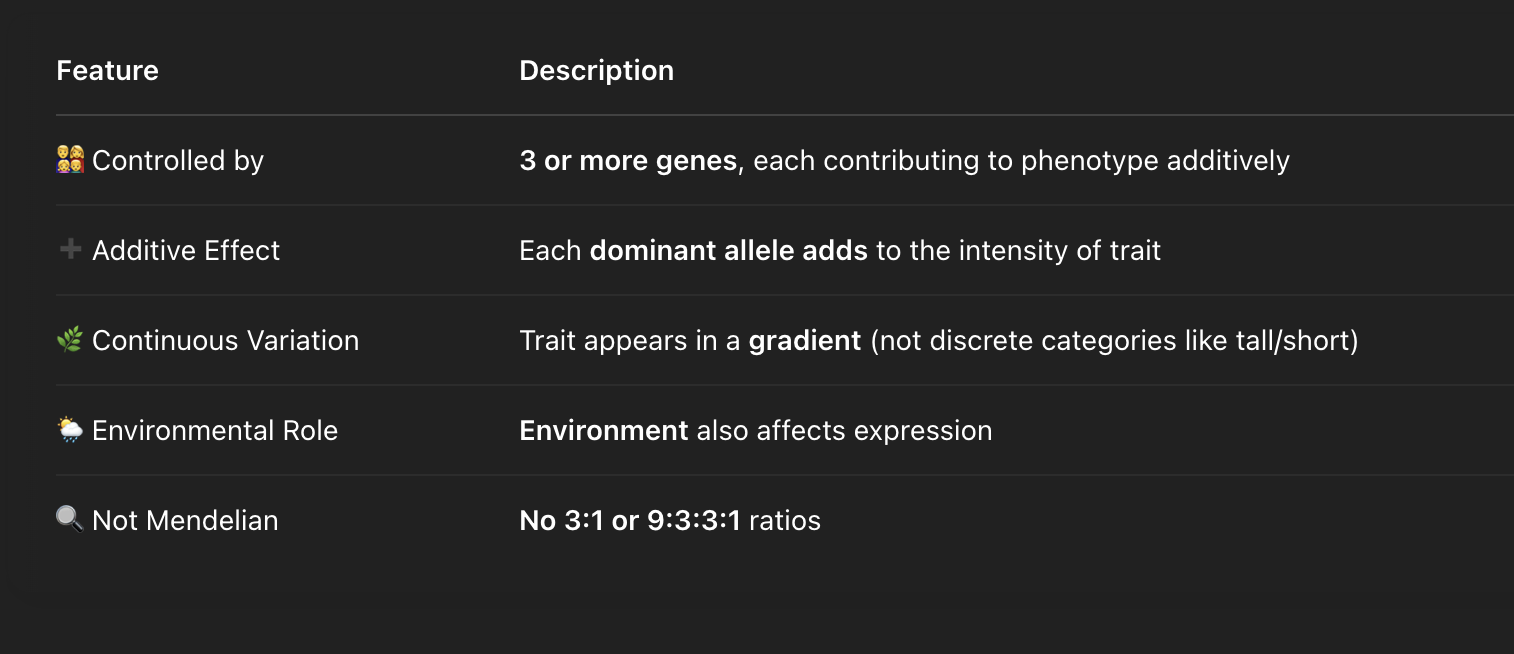
🌈 Classic Examples:

🔬 Skin Colour – NCERT Example:
Assume genes A, B, C contribute to dark skin tone:
🧠 Each dominant allele (A, B, C) = adds pigment
📉 Each recessive allele (a, b, c) = no pigment

🎨 Visual Spectrum of Polygenic Trait:
Lightest → aabbcc
AaBbcc
AaBBcc
AaBbCc
AABbCc
AABBcc
Darkest → AABBCC
🧬 7 phenotypic classes possible in F2 generation of 3-gene polygenic cross
🧠 Quick NEET Insights:
Traits controlled by multiple genes = polygenic
Additive = more dominant alleles = stronger trait
Not governed by Mendel’s ratios
Environment can modify expression
🧬 Pleiotropy
(One gene → many traits!)
Definition:
When a single gene affects multiple phenotypic traits, it is called pleiotropy.
🧠 "Pleiotropy" = one gene, many effects
2. Phenylketonuria is an example of pleiotropy because:
A. It involves multiple gene mutations affecting a single phenotype
B. A single gene mutation affects multiple phenotypes like brain development and pigmentation
C. It is caused by a chromosomal abnormality
D. It affects only the kidneys but shows multiple symptoms
✅ Correct Answer: B
Explanation: PKU results from a mutation in one gene, but affects mental development, hair, and skin pigmentation — multiple traits.
The gene responsible for phenylketonuria encodes which of the following enzymes?
A. Tyrosinase
B. Phenylalanine hydroxylase
C. Trypsin
D. Aminotransferase
✅ Correct Answer: B
Explanation: The faulty gene in PKU prevents the production of phenylalanine hydroxylase.
🎯 Key Features:

🧪 NCERT Example: Phenylketonuria (PKU)
2. Reduced hair & skin pigmentation |

💡 Single gene mutation → affects multiple systems
🧠 Why Pleiotropy Happens?
Gene → codes for enzyme or protein
That protein may be used in many different cells/functions
Disruption affects multiple traits
Which of the following symptoms is not typically associated with phenylketonuria?
A. Mental retardation
B. Increased melanin production
C. Hypopigmentation
D. Accumulation of phenylpyruvic acid in urine
✅ Correct Answer: B
Explanation: PKU leads to reduced melanin, not increased melanin.
Assertion (A): Pleiotropy involves multiple genes contributing to a single phenotype.
Reason (R): Pleiotropy explains polygenic inheritance patterns.
A. Both A and R are true, and R is the correct explanation of A.
B. Both A and R are true, but R is not the correct explanation of A.
C. A is true but R is false.
D. A is false but R is true.
✅ Correct Answer: D
Explanation: Pleiotropy = 1 gene → many traits. Polygenic = many genes → 1 trait.
ou are shown the following gene expression pathway:
rustCopyEdit
Phenylalanine --[X]--> Tyrosine --> Melanin (pigmentation) ↓ Brain neurotransmitter synthesis
3. Based on the diagram, which of the following effects would result from a mutation in gene ‘X’?
A. Increased melanin and improved brain function
B. Accumulation of tyrosine and normal brain development
C. Decreased pigmentation and mental retardation
D. Overproduction of phenylalanine hydroxylase
✅ Correct Answer: C
Explanation: Mutation in the enzyme X (phenylalanine hydroxylase) leads to build-up of phenylalanine and lack of tyrosine → less melanin & brain issues.
Assertion (A): Phenylketonuria is considered a pleiotropic genetic disorder.
Reason (R): In phenylketonuria, a mutation in a single gene affects multiple traits like brain function and pigmentation.
A. Both A and R are true, and R is the correct explanation of A.
B. Both A and R are true, but R is not the correct explanation of A.
C. A is true but R is false.
D. A is false but R is true.
✅ Correct Answer: A
🌟 NEET Points to Remember:
One gene, many phenotypes = pleiotropy
Common in metabolic disorders
Not to be confused with polygenic inheritance
PKU = classic example (NCERT must-know)
🧬 Sex Determination Mechanisms
(How organisms decide who’s male or female!)
🔍 Historical Background:
Henking (1891): Discovered a nuclear structure during spermatogenesis in insects → named it X-body
Later discovered to be the X-chromosome
🧪 Types of Sex Determination 1⃣ XO Type (e.g. Grasshopper)
Sperm types: With X / Without X
Egg: Always X
Fertilisation:
Egg + X → Female
Egg + no X → Male
🔄 Male Heterogamety

2⃣ XY Type (e.g. Humans, Drosophila)
Sperm types: X / Y
Egg: Always X
Fertilisation:
X + X → Female
X + Y → Male
🔄 Male Heterogamety

3⃣ ZW Type (e.g. Birds, Reptiles)
Egg types: Z / W
Sperm: Always Z
Fertilisation:
Z + Z → Male
Z + W → Female
🔄 Female Heterogamety

🧠 KEY TERMS to Remember
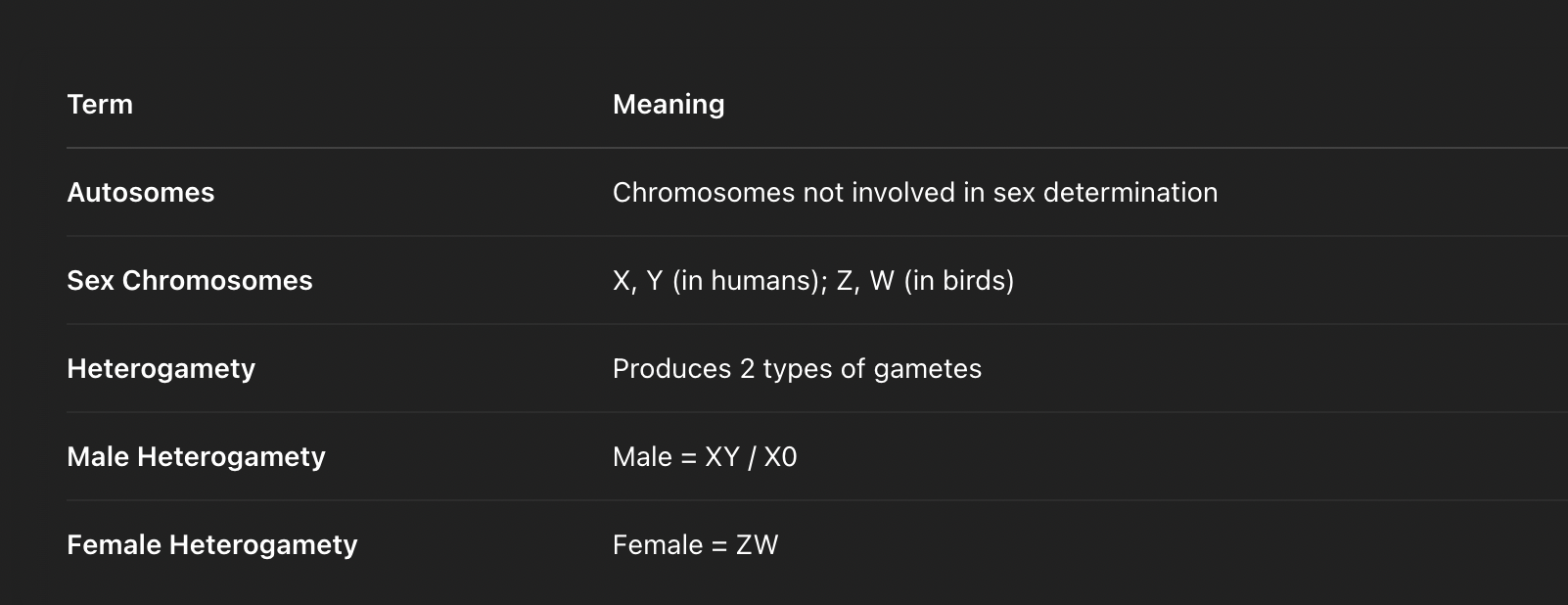
🌟 NEET Quick Facts
Humans & Drosophila: XY → Male; XX → Female
Grasshoppers: XO → Male; XX → Female
Birds: ZZ → Male; ZW → Female
Males are heterogametic in XY & XO systems
Females are heterogametic in ZW system
📊 Chromosomal Basis:
Humans have 23 pairs of chromosomes
22 pairs → Autosomes (same in both sexes)
1 pair → Sex Chromosomes
Female: XX
Male: XY
🔄 Gamete Formation
Parent | Gametes Produced |
|---|---|
Male | 50% X-sperm + 50% Y-sperm |
Female | 100% X-egg |
🧪 Fertilisation Outcome
Sperm Type | Ovum (X) | Resulting Zygote | Sex |
|---|---|---|---|
X-sperm | X | XX | Female |
Y-sperm | X | XY | Male |
🟢 Conclusion:
✅ Sperm determines the sex of the child
✅ Each pregnancy has a 50% chance of producing either a boy or a girl
⚠ Social Misconception
❌ It is scientifically incorrect to blame women for the sex of the child
🔬 The father’s sperm determines whether the baby will be male or female
NEET Key Points
Sex is determined at the time of fertilisation
Only sperm can carry X or Y, egg always carries X
XY = male, XX = female
Equal probability for male or female child = 50:50
Sex determination is purely genetic, not environmental
🐝 Sex Determination in Honey Bee ⚙ System: Haplodiploid Mechanism
🔬 Chromosomal Basis
Individual | Chromosome Number | How it Develops | Sex |
|---|---|---|---|
Female (Queen/Worker) | 32 (Diploid) | Fertilised egg (Sperm + Egg) | Female |
Male (Drone) | 16 (Haploid) | Unfertilised egg (Parthenogenesis) | Male |
🌟 Key Features
Females = Diploid (2n = 32) → Develop from fertilised eggs
Males = Haploid (n = 16) → Develop from unfertilised eggs
Males are produced without fertilisation → Parthenogenesis
Males produce sperms via mitosis (since they are haploid and cannot undergo meiosis)
Males have no father, but they have a grandfather
Males cannot produce sons, but they can produce grandsons
📘 NEET Hot Points
Sex determination based on ploidy level, not sex chromosomes
Parthenogenesis = development from unfertilised egg
A unique example of male haploidy in animals
Sperm is not needed to form male in honey bees!
🐣 What about Birds? ⚙ System: ZW Sex Determination
Parent | Sex Chromosomes | Gametes Produced |
|---|---|---|
Male | ZZ | Only Z-type sperm |
Female | ZW | Both Z and W eggs |
Egg decides the sex of the chick in birds!
Z + Z = Male, Z + W = Female
Females are heterogametic (ZW), Males are homogametic (ZZ)
🧬 Mutation & Pedigree Analysis (NCERT Class 12 - Genetics)
🔄 MUTATION: Source of Genetic Variation
Type of Mutation | Description | Example |
|---|---|---|
Point Mutation | Change in a single base pair | 🩸 Sickle Cell Anemia |
Frame-shift Mutation | Insertion/Deletion of bases → shifts reading frame | 🧬 Causes multiple incorrect amino acids |
Chromosomal Mutation | Loss or gain of large DNA segments | 🚨 Cancer cells often show this |